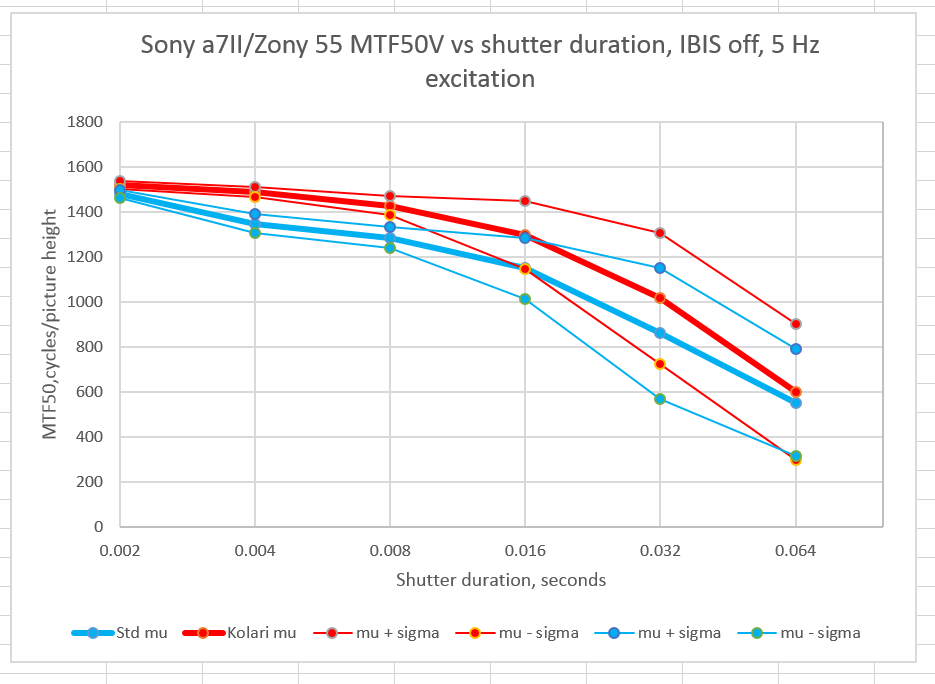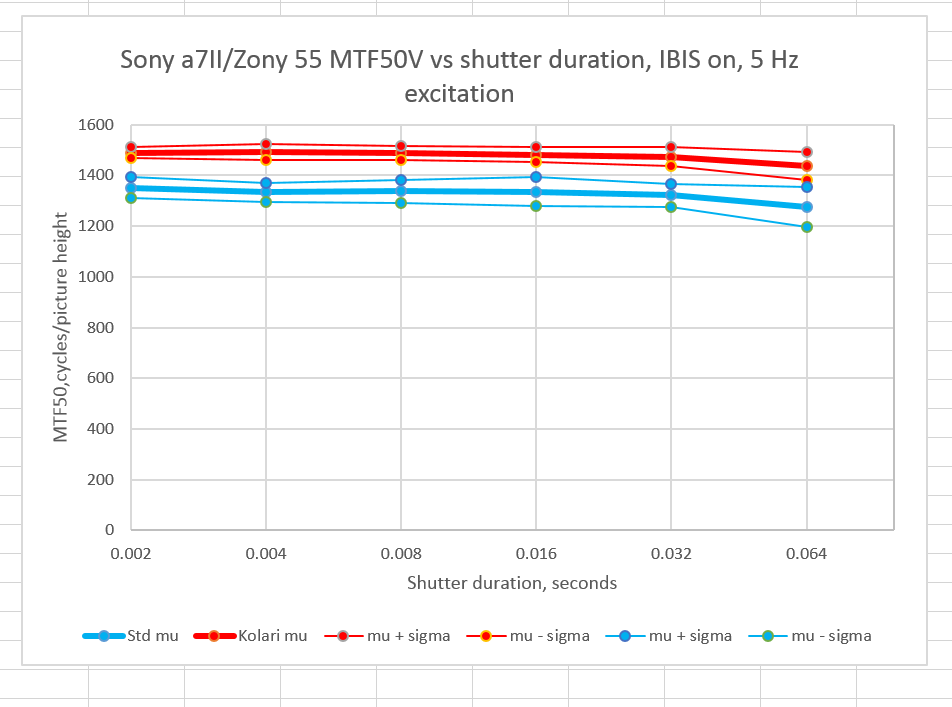So far, I’ve written 18 posts on the prototype Kolari-modified Sony alpha 7II with various rangefinder lenses attached, and also, as a control, with the Sony-Zeiss 35mm f/2.8 FE. The series starts here. Kolari has been shipping thin sensor stack modified a7’s for quite some time, and the a7II sensor and sensor stack are very similar. So what’s the fuss about an a7II version?
The difference, from: Kolari’s perspective, is that the a7II has in body image stabilization (IBIS), and the a7 doesn’t. Kolari’s modification changes the weight of the sensor stack, and that could conceivably affect the way that IBIS performs. The folks at Kolari asked me to look into that.
I first tried to perform the same sort of handheld MTF testing that I performed on the a7II on both a modified and an unmodified camera. There was too much noise in the results for me to draw any firm conclusions. The noise comes from the non-repeatability, from shot to shot and session to session, of the handholding steadiness. I might be able to solve this by doing many more than 16 shots per data point, but the testing is already laborious and time-consuming. In order to reduce the noise by a factor of two, assuming that my unsteadiness is Gaussian, I need to go to 64 shots per data point. To reduce the noise by a factor of four would take 256 shots per data point. I can’t bear to even think about that.
After looking at the noisy handheld results, I came to the conclusion that I needed a repeatable, mechanical way to vibrate the camera. I started out by purchasing a used laboratory orbital shaker, which originally served to agitate samples in the hospital setting. It was cheap. It was sturdy. However, when I finally received it, it was broken.
I swallowed hard and bought a new one. It’s amazing what you can buy on Amazon. This one had a digital speed setting device, rather than the potentiometer of the first one, which should serve to make the results more repeatable. The way these things work is that they move a tray horizontally in about 1 inch circle. The speed at which a complete rotation takes place is variable between some low value and 300 or 500 RPM. The size of the circle is not variable.
I put the camera on a tripod, focused on the target, put 1 leg on the tray, and turn the shaker on. Whoops! The circle was way too big – so big, in fact that the tripod started walking around the room. I got a piece of aluminum foil and put it under the bottom of the tripod leg that was on the tray, so that it could slip. Better, but no cigar. The motion was still too great.
Then I had an idea. The shaker came with some magnetic posts that would stick to the tray. What if I put a rubber band around one of those posts, and attach the other end to the tripod leg? I could control the excursion of the tripod leg to some extent by the tartness of the rubber band. I wouldn’t have repeatability from session to session, but I would definitely have it within a session. I tried it, and it seemed to work just fine.
The next question was: how fast to tell the tray to move? I started with 60 RPM, or one cycle per second. Too slow. The IBIS seemed to consider motion that slow to be the users deliberately aiming the camera at a new point, and it did very little to correct it. I turned the speed all the way up to 300 RPM, or 5 Hertz. The IBIS seemed to consider that speed the jitter of an unsteady hand, and did what appeared to be a great job of correcting it when I looked at the magnified life your display.
Here’s the test protocol:
- A single Fotodiox LED-200WA-56 daylight balanced flood.
- Sony-Zeiss 55mm f/1.8 FE lens.
- ISO set to 800, f-stop set to 8,
- Focusing manually on the Siemens star in the slanted-edge target using maximum magnification and focus peaking wide open,
- Drive set to single
- EFCS on
- Manual exposure mode.
- Camera on tripod that’s attached to the shaker with a rubber band.
- Exposure protocol: Light to maximum,, shutter to 1/500 second, make 16, Turn the light down a stop, make 16 exposure, until you get to 1/15 of a second.
- Make one series with IBIS on, and one with it off.
- Develop in Lightroom CC 2015 with standard settings.
- Crop, export as TIFFs, analyze for vertical edge MTF50 in Imatest version 4.
- Find the files for which Imatest improperly identified the ROI, and replace them with the extra files. This is a manual, fiddly, boring, unpleasant operation.
- Export the results to Excel, crunch the stats, and graph.
I did a test run with the Sony 55, with both cameras with the IBIS off.
These are the results:
The vertical axis is the MTF50 for the image: the point where, as the spatial frequency of the subject matter increases, the response on the sensor is reduced to half its very-low-frequency value. The units of spatial frequency are cycles per picture height. Since the a7II has a picture height of 4000 pixels, the highest that the MTF50 should ever get is 2000 cycles per picture height. 1500 is exemplary performance, and not something we are likely to ever see with edges perpendicular to the strong axis of the a7II’s anti-aliasing filter .
The horizontal axis is the shutter duration. The points on the graph correspond to 1/500, 1/250, 1/125, 1/60, 1/30, and 1/15 second.
The heavy lines are the average for all 16 exposures. The red is the Kolari-modified camera, and the blue is with the standard one. The light lines are the average plus one standard deviation and the average minus one standard deviation. If the statistics for handheld MTF50 turn out to be Gaussian, about two thirds of the images will fall between the two narrow lines. Mu stands for mean. and sigma for standard deviation.
The fact that the modified camera does better than the unmodified one at moderate and fast shutter speeds is probably due to the fact that the modification removes the antialiasing filter.
Turning IBIS on, we see the following:
It’s clear that, in this case, the IBIS operation is in no way impaired by the Kolari modification.
A few caveats are in order. This is a test that does not subject the cameras to all the possible forcing functions that they would see in normal handheld operation, so it is not definitive. It is clear that the IBIS performs better with the shaker 5 Hz input than it does with normal handheld jitter, probably because the shaker excitation is always within the amount that can be corrected with the amount of travel available in the IBIS mechanism, but also possibly because higher frequencies are present in human hand holding. I could experiment with different forcing frequencies, but I have no idea what the proper frequency/amplitude envelope for human ones is.
To really do this right, we’d instrument a camera being held by a person and measure 6-axis g forces. Then we’d mount the unit under test on a 6-axis electronic shaker and feed it the waveforms measured at the camera.
I suspect that’s how Sony and Nikon do it, but that experiment is beyond my expertise, spare time, and pocketbook.


Lynn Allan says
A vibrator like rifle shell reloaders use might be a less expensive, but suitable replacement.
Or electric hair clippers or shaver taped to a leg of the tripod?
Moot point, as you were able to get what appear to be suitable measurements?
Are the numbers shown from Imatest (or equivalent)? I don’t recall your use of Imatest in previous articles, but perhaps I missed that.
If so, have you tested (on considered) measuring the impact of “shutter shock” for the original a7r? IIRC, you worked out a way to have objective info with an oscilloscope.
Perhaps you could have lp/mm’ish numbers for the various ways you attempted to reduce shutter shock. I recall you being more or less satisfied with a machined weight to dampen vibrations.
I’d find it interesting to read that a “best case optimal” that showed what the a7r was capable of (like #### lp/mm with 24mm FL and either long or very short exposure) was reduced to #### lp/mm with the worst case of 200 mm FL and 1/100 sec.
BTW, is there a way to get notified when there is a reply/update to a blog article that I leave a comment on?
Jim says
From Imatest. Whenever I’ve done real camera slanted edge MTF curves, I’ve used Imatest. When I’ve some cures from simulations, I sometimes use Burns’ sfrmat3 code.
Jim
Jim says
have you tested (on considered) measuring the impact of “shutter shock” for the original a7r?
Yes. Take a look here:
http://blog.kasson.com/?p=5296
Jim
Lynn Allan says
Thanks for the link (and for the testing of thea7Rii).
It wasn’t obvious to me just what the charts and narrative showed. I read the link, and the one previous to it.
It seemed like the V line was “portrait orientation” and the H was “landscape mode”. Correct? H tended to be better, as expected. Or do I have it backwards?
I suppose those charts indicated by 1+ seconds and longer, shutter shock was a non-issue. 0.02 (1/50s) was pretty bad.
Did you do tests on the a7R with the “machined weights” that dampened vibrations, so shutter speeds of 1/200 to 1/20 would be much less impacted by shutter shock?
Jim says
I tried a few and reported on them, but I never got results that satisfied me. Then the D810 came out and I stopped using the a7R. Did Joe Holmes ever get his tungstan weights?
Jim
Jim says
V is vertical edges. H is horizontal edges.
Jim says
If you use the lower RSS link you can subscribe to all comments, but I’ve no way to notify you for the subset that you describe. Sorry.
Jim
Ilya Zakharevich says
> I have no idea what the proper frequency/amplitude envelope for human ones is.
IIRC, the level-of-dumping vs. frequency graph for K–M 7D (?) was published. IIRC, it was flat about 8Hz–80Hz, with a strong fallback outside this range.
I would read this as: 5Hz is not relevant to handshake elimination. Moreover: the difference of masses should not be important for low frequencies. (Which makes the results of your — otherwise very ingenious — experiments kinda moot.)
BTW, AFAIK, the protocol for measuring handshake reduction is standardized. IIRC, I even downloaded it once — but had not time to inspect it…
Charlie Webster says
Really superb tests from beginning to end, on the whole Kolari issue. Thanks so much for all your work 🙂